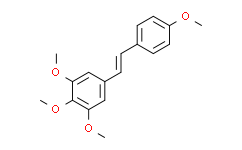| Cas No.: | 134029-62-2 |
| Chemical Name: | Benzene,1,2,3-trimethoxy-5-[(1E)-2-(4-methoxyphenyl)ethenyl]- |
| Synonyms: | Benzene,1,2,3-trimethoxy-5-[(1E)-2-(4-methoxyphenyl)ethenyl]-;1-(4-methoxyphenyl)-2-(3,4,5-trimethoxyphenyl)ethene;1,2,3-trimethoxy-5-[(1E)-2-(4-methoxyphenyl)ethenyl]Benzene;3,4,5,4'-TETRAMETHOXYSTILBENE;1,2,3-trimethoxy-5-[(E)-2-(4-methoxyphenyl)ethenyl]benzene;1,2,3-Trimethoxy-5-[(E)-2-(4-methoxyphenyl)vinyl]benzene;benzene, 1,2,3-trimethoxy-5-[(E)-2-(4-methoxyphenyl)ethenyl]-;1,2,3-Trimethoxy-5-[(1E)-2-(4-methoxyphenyl)ethenyl]-benzene;DMU 212;MR-4;(E)-1,2,3-Trimethoxy-5-[2-(4-methoxyphenyl)ethenyl]benzene;DMU-212 |
| SMILES: | COC1C=C(/C=C/C2C=CC(OC)=CC=2)C=C(OC)C=1OC |
| Formula: | C18H20O4 |
| M.Wt: | 300.349 |
| Purity: | >98% |
| Sotrage: | 2 years -20°C Powder, 2 weeks 4°C in DMSO, 6 months -80°C in DMSO |
| Description: | DMU-212 is a methylated derivative of Resveratrol (HY-16561), with antimitotic, anti-proliferative, antioxidant and apoptosis promoting activities. DMU-212 induces mitotic arrest via induction of apoptosis and activation of ERK1/2 protein. DMU-212 has oral bioavailability[1][2]. |
| In Vivo: | DMU-212 (50 mg/kg; i.g.; three times a week; for 14 days) inhibits tumor growth in xenograft model of human ovarian cancer[2]. Animal Model: 6-weeks-old SCID female mice (20-24 g), with ovarian cancer xenografts[2] Dosage: 50 mg/kg Administration: Oral gavage, three times a week, for 14 days Result: Lower tumor burden. |
| In Vitro: | DMU-212 (0.3125-40 μM) inhibits growth of A375, MeWo, Bro and M5 cells human melanoma cells[1]. DMU-212 (30-50 μM; 24 hours) induces upregulation of cell cycle inhibitors, apoptosis and ERK activation in A375 cells[1]. DMU-212 induces upregulation of cell cycle inhibitors, apoptosis and ERK activation in A375 cells[1]. DMU-212 induces G2/M arrest and apoptosis in cancer cells[1]. DMU-212 induces mitotic arrest, apoptosis and activation of ERK1/2 protein[1]. Cell Proliferation Assay[1] Cell Line: A375 cells, MeWo cells, M5 cells, Bro cells Concentration: 0.3125 μM, 0,625 μM, 1.25 μM, 2.5 μM, 5 μM, 10 μM, 20 μM, 40 μM Incubation Time: 96 hours Result: Inhibited the cellular proliferation of human melanoma cells at submicromolar or micromolar concentrations (IC50=0.5 μM for A375 and Bro and IC50= 1.25 μM for MeWo and M5 cells). Cell Cycle Analysis[1] Cell Line: A375 cells Concentration: 20 μM, 30 μM, 50 μM Incubation Time: 24 hours Result: Caused a marked increase in the levels of p21, p53 and cyclin B1 proteins with a concomitant decrease in the levels of cyclin A2. Western Blot Analysis[1] Cell Line: A375 cells Concentration: 20 μM, 30 μM, 50 μM Incubation Time: 24 hours Result: Significant upregulation of Bax, caspase 3 and caspase 9 protein levels, while the levels of the anti-apoptotic protein Bcl-2 were decreased. |
| References: | [1]. Vasilis Pericles Androutsopoulos, et al. Activation of ERK1/2 is required for the antimitotic activity of the resveratrol analogue 3,4,5,4'-tetramethoxystilbene (DMU-212) in human melanoma cells. Exp Dermatol. 2015 Aug;24(8):632-4. [2]. Hanna Piotrowska, et al. DMU-212 inhibits tumor growth in xenograft model of human ovarian cancer. Biomed Pharmacother. 2014 May;68(4):397-400. |

 DC Chemicals' products qualify for U.S. tariff exemptions. We guarantee no price increases due to customs duties and maintain stable supply, continuing to deliver reliable research solutions to our American clients.
DC Chemicals' products qualify for U.S. tariff exemptions. We guarantee no price increases due to customs duties and maintain stable supply, continuing to deliver reliable research solutions to our American clients.





















